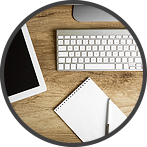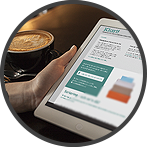Create a digital shortcut in a physical space
Datum: 2024-10-22 12:00

Having the right information at hand just when you need it is simply amazing. If you are in the middle of doing something and are hindered in your progress halfway through since there is something you need to know to move on, you want to find the answer to your question or problem as soon as possible. It can be that a colleague has certain information regarding what you are working on, that the device you are working on keeps sending you error messages that you need to understand and solve before you continue working, or that you need to find a cheat sheet describing how something is done.
For you who prefer listening to reading, this post is also available as an episode of the “Done!” podcast:
Stressful stops
If you then cannot reach the colleague you need, find the manual or locate the quick reference guide, you will most likely be annoyed, to say the least. The clock is ticking and what you could have been done with quickly now takes up much more of your day than you had intended it to.
A code at the office
When I held a lecture for the administrative staff at the Swedish University for Arts, Crafts and Design, recently, I discovered a small but clever detail they use and which I would like to see in more offices and organizations (my own included).
Outside of the door to the IT-department, there was a sign with the heading ”IT-FAQ” with a big QR-code that was impossible to miss underneath. The person who is in dire need of IT-support and who therefore heads on down to this very department could most likely find the answer to their question without even stepping through the door (regardless of if the support staff are in or not). You scan the QR-code with your smartphone and will be instantly redirected to the intranet-page where the solutions to the most frequently asked questions and problems the employees have are listed.
Is this not a clever solution? It really appeals to me, especially since it is so easy to scan QR-codes nowadays. If you have an iPhone you just ”aim” at the code through your camera-app and if you use Android and, for instance, the phone Samsung Galaxy, you simply open the web browser and do the same thing. The digital information you need to have in a certain physical location is then readily available, just a click away.
Do this
If you want to follow this great example, then
- Take a moment to think about where in your everyday life you could use having access to some kind of digital information that is not naturally or easily available in this place or location. This could, for example, be:
- A cheat sheet describing how you do something you do not do very often.
- A document in a cloud-service into which you need to enter a value after reading it from a physical gauge, gadget, or apparatus that is not located anywhere near your computer.
- A page on the web where the information changes so quickly that there is no use to print it out or making a physical sign out of it.
- Create a QR-code using, for instance, the service QR Code Generator.
- Print it out and paste it wherever it needs to go.
- Done!
Find it fast
If you by using QR-codes create shortcuts through the physical space and world to digital information and materials, you will neither need to remember nor enter the address, URL, or password to the place where the information actually is located.
Instead of filling your phone with shortcuts, you will have only one shortcut for every place that needs one and it will be located in the place where it is actually needed instead of on your phone. You will keep the motion going in whatever you are doing and will find what you need — when and where you need it.
What’s your way?
Have you used QR-codes in some other clever way? If so, feel free to write about your application or use of this smart solution in the comment section.
(Do you know how to take a shortcut to realizing your vision?)
There's more!

If you want more tips on how to create good structure at work, there are many ways to get that from me - in podcasts, videos, books, talks and other formats.




